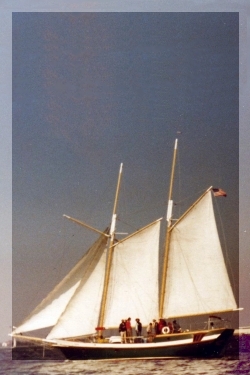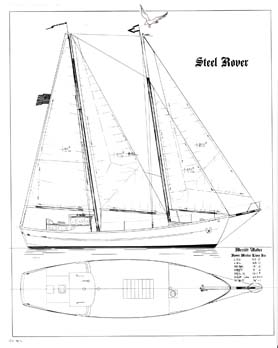The return of commercial sail, up until a few months ago, was considered to be a dream of romantics. Practical seamen did not have time for such foolishness. However, because of several successful working sail vessels, particularly in the fishing industry, sails are becoming commonplace for fuel conservation.
The Steel Rover is a second-generation Trade Rover design, in response to requests for a well-stayed Marconi rig with shortened bowsprit, for use by watermen without sail experience.
Sail power, as is true of engine power, comes in an infinite variety of configurations, all with their own following and proponents. Just as there are racing engines and working engines, there are racing sail rigs and working sail rigs. A proper working sail rig must be so designed that, among other considerations, it does not increase crew size nor hamper normal operations of the vessel. In a nutshell, the working sailor should be wary of gadgets. As yet, I have seen nothing more functional or dependable than a conventional rig as shown on the Steel Rover, and fortunately, cost is low.
As for the hull form, the Steel Rover is single chine with approximately 20,000 pounds of cargo capacity in a space twenty-four feet long. She has exceptionally good sailing lines for her bulk. As is true of the Trade Rover, she has a seawater ballast system for optimum trim and stability in all loading conditions. Furnished with the set of plans are curves of form for easy determination of tons per inch immersion, moment to trim one inch, etc.
The plans are drawn at a scale of 3/4" to the foot and consist of an outboard profile, inboard profile, lines and table of offsets (computer faired), frame sheets, ballast tank plans, rig plan, and miscellaneous details.
Construction is 1/4" bottom plates, 1/4" lower sides, 3/16" upper sides and deck. Frames are longitudinal flat bar on flat bar transverse frames on 48" centers. The box keel is 1" bottom and 1/2" sides; total steel weight is roughly 30,000 pounds. Although she is a handful for the amateur, it can be done. In fact, the first Trade Rover was launched in about a year and a half by a builder with no prior experience and no help or facilities beyond the normal backyard setup.
<top>


